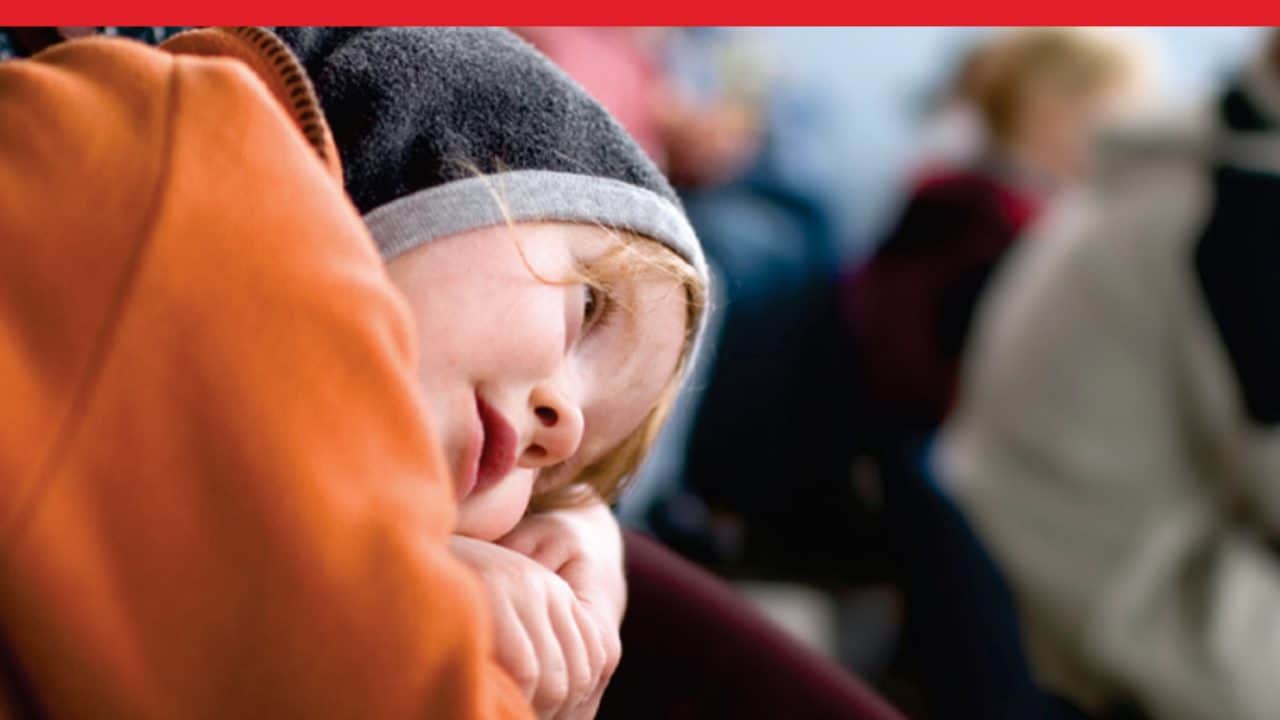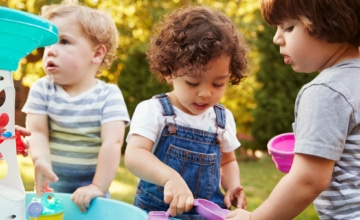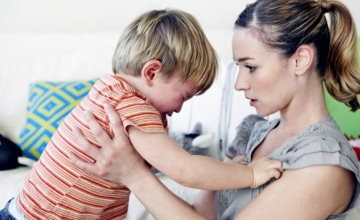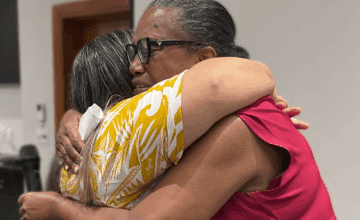Joy D. Osofsky, Louisiana State University Health Sciences Center, New Orleans
Abstract
Lessons learned from providing support to young children and families affected by natural disasters and other traumatic events can help in the response to the COVID-19 pandemic. While the uncertain and invisible nature of the pandemic presents some unique challenges, early childhood professionals can draw upon proven practices to help families protect and support children. Effective practices include establishing new routines, managing challenging behavior, considering developmental needs, and processing grief and loss. The author suggests actions to take that foster resilience in the face of ongoing uncertainty.
Professionals who work with young children and their families have learned much over the years about ways to support children of all ages with preparation, response, and recovery following disasters. However, the COVID-19 pandemic introduces a new type of disaster unlike others as it is characterized by “indefinite uncertainty.” Natural disasters such as hurricanes, tornadoes, forest fires, earthquakes, or even tsunamis can be incredibly destructive, but they have beginnings and endings. The experience I have had with natural and technological disasters that comes closest to the COVID-19 experience is the effects of the Fukushima Daiichi nuclear disaster in 2011. The perspectives that I learned in listening to the parents of young children as well as pediatric and mental health professionals may lend some insight related to ways to cope and be supportive around COVID-19 pandemic.
During the nuclear disaster, families were concerned about their young children’s exposure to radiation because, despite being reassured that only a safe level of radiation was in the air where they lived, parents worried that being out and breathing the air would be harmful. They felt they needed to take control and they were concerned about a possible danger that could not be seen, so they obtained detector devices to measure the level of radiation themselves. In the area of Japan where I was working, just 45 miles from the Fukushima Daiichi nuclear facility, parents and caregivers believed they needed to learn more and be more in control and safer by continually measuring the level of radiation, wearing long sleeves when they went outside, and taking other preventive measures such as always washing hands when they came inside. Further, they adjusted their lives to attempt to ensure more safety for themselves and their children by staying inside most of the time.
With the COVID-19 pandemic, the danger is also invisible and therefore very difficult to control so that children and families need to find ways to take control that make sense to them such as washing hands, social distancing, wearing masks, and avoiding crowds. They also have to find ways to adapt, adjust, and live with the “indefinite uncertainty” which contributes to much anxiety. Fear of the unknown and a danger that cannot be seen can lead to fear and anxiety. The level of indefinite uncertainty as a result of the COVID-19 pandemic has not been experienced worldwide for many generations. And for too long in response to both natural and technological disasters, the needs of young children have been under-recognized because of the myths that they are too young to be traumatized, do not understand, and that they “will get over it.” However, consistent with previous work on trauma and disasters (Osofsky et al., 2015; Osofsky, 2011), the facts indicate that the impact on infants and young children from these frightening events ranges from changes in brain development for infants to behavior and emotion dysregulation for young children that is similar to the effects of trauma on young children.
With COVID-19, life and routines for children are very different, first with lockdowns, social distancing restrictions, school closures, virtual education, and now with the uncertainty about whether and in what ways preschools and schools will open. With the many restrictions and changes required to keep people safe, it may be very difficult to totally protect young children from experiencing at least some of the stress and anxiety of their parents or caregivers. When children older than 28 months experience trauma, they retain verbal recall of the event (Fivush, 1998). Those younger than 28 months have behavioral recall seen later in their play and in unexpected reenactments. My colleagues and I observed these behaviors and play vividly after Hurricane Katrina when, at the first opportunity after being displaced by the hurricane, the young children immediately played hurricane with blocks and other toys re-enacting their experiences of the storm.
Protecting and Supporting Children
Young children can be both protected and supported during the COVID pandemic. Parents and caregivers need to be available to listen to the children, even young children, and find out what they know and their concerns. It may be helpful to think about Mr. Rogers’ approach that was simple: Listen. “When children bring up something frightening,” he said “it’s helpful right away to ask them what they know about it. We often find that their fantasies are very different from the actual truth. What children probably need to hear most from us adults is that they can talk with us about anything and that we will do all we can to keep them safe in any scary time. (cited in Rosenwald, 2018)
Establish Routines
Young children will be affected by the changes in routines, such as not going to child care or preschool, having siblings at home, parents working from home, not being able to see their relatives or grandparents, not being able to go out to play. In order to protect them, self-care for parents and caregivers is important. This includes limiting media exposure about news, except to be informed, having discussions about COVID-19 only when and where children cannot easily overhear, and, most important, establishing new schedules and routines that take into account the needed changes and the “new normal.” However, it is also important for parents and caregivers to share what they know about COVID in a “child-friendly” way, to have some of the many child-friendly resources available to help with explanations about ways to stay safe, and to explain how children can also play a role by washing their hands when needed.
Parents and caregivers also need to recognize that schedules may need to be adjusted frequently related to ongoing changes in availability of child care centers, preschools, and general school re-opening. School reopening may continue to be uncertain and changing, which requires flexibility for parents and caregivers. Virtual learning, as is being done by many schools for children who are old enough, will require additional adjustments. Further, for families that include essential workers, additional restrictions may be required for safety, necessitating more explanations for children including creative ways to be connected via social media if possible, telephone calls, writing notes or drawing pictures, and other creative ways to connect.
Manage Challenging Behavior
The continuing uncertainty may cause young children to react with emotional and behavioral dysregulation as they sense the increased anxiety, concerns of parents, and the changing situation at home. In addition, young children may have difficulty going to sleep and staying asleep, problems with eating, increased irritability, crying, clingy behavior, and difficulty separating from familiar caregivers. Further, regressions in already achieved development, such as toilet training or drinking from a cup, may occur.
Understand Developmental Needs
In addition, the COVID-19 pandemic, with uncertainties about both cause and duration, is bringing attention to meeting the important psychological, social, and developmental needs of young children that may be missed without seeing familiar friends and relatives and by the required social distancing. Questions are being raised about the effects on early social and emotional development if children are more isolated, being mainly in their homes with primary caregivers. Further, will children between 2 and 5 years old have the opportunity to experience and develop what is needed for normal socialization if they cannot share and play with other children their age? These questions and others are placing increased responsibility on parents and caregivers to find ways to support these important components of early development. Recent contributions from ZERO TO THREE (see Learn More box) suggest ways that parents and caregivers can use toys, books, and media to encourage interactions and develop virtual relationships to support this development.
Process Loss and Grief
Issues of loss and grief are very important to consider related to young children and families during COVID-19. Of particular concern is the African American population for whom the incidence of illness and death is much higher than other racial and ethnic groups, and who have suffered historical inequities as well as inequities in care. For children in families who have lost friends, relatives, and family members, reactions to loss and grief may include regressions such as a return of behaviors more typical of an earlier age. For these children, it is crucial to offer a space for the child to be heard and to let them know that it is safe to talk to you about their sadness and grief. It is unfortunate that cultural traditions related to funerals as a way to help families reach some type of closure after a death are not possible during COVID-19.
Fostering Resilience
At present, it seems likely that, for some period of time, young children, parents, and caregivers will have to continue to adapt to the indefinite uncertainty around COVID-19. Therefore, consider not only the traumatic and negative impacts of the pandemic on young children and their caregivers, but also what is important to support them and to encourage resilience. Fostering resilience in young children will help them develop ways to enjoy positive experiences and events and also learn how to deal with more difficult situations and overcome adversities. The most important factor in fostering resilience is to be able to depend on a secure, trusting relationship with a parent or caregiver. From that relationship, the child will learn to trust and be able to negotiate more difficult situations from what Bowlby referred to as a “secure base” (Bowlby, 2005).
However, during COVID-19, it may take even more effort than at other times for a parent or caregiver to be able to be emotionally available and fully there with a child because of the depletion of the mental and physical adaptive systems that adults depend on in times of stress—such as during natural disasters (Mills, 2020). Masten (in a podcast conversation with Mills) referred to this situation as depletion of the “surge capacity” that is needed to be able to cope with the continuing and indefinite uncertainty of COVID-19. Self-care for adults is very important at this time to support their resilience and capacity to deal with the continually changing situation. It is also important to recognize that the indefinite uncertainty about the pandemic may be particularly difficult for people who are most comfortable with organizing their lives, being in control, solving problems, and getting things done. Adults need to learn ways to adjust to a “new normal” when the situation may be continually changing. It may be helpful at this time for parents and caregivers to include self-care activities that have worked in the past and also to find new activities to provide support.
In considering ways to foster resilience, remember that the most important protective factors for facing adversity include social support and remaining connected to people. My colleagues and I also found that for both adolescents and adults, giving to others following disasters was an important way to help with recovery, promote self-esteem, and support resilience (Osofsky et al., 2018). Building resilience may also require changing perceptions of the situation with COVID-19. The broad impact of the pandemic cannot be changed, and life is different now and, in many ways, more difficult.
Given the continuing uncertainties due to the COVID-19 pandemic, it is important to build on what researchers have learned may be helpful for parents and caregivers in providing support for their young children. With the “new normal,” the following may be helpful:
- Having routines and a schedule is important even if it needs to change frequently. Involve the child in planning the schedule which will help both the parents and children be more regulated.
- Start with small changes that may work with the idea that, over time, they can find other changes that can make each day a little better organized and easier.
- Think more about things they really enjoy doing such as trying to make connections with friends and family virtually or by telephone, knowing that in-person visiting may need to wait.
For everyone, it is important at this time, as during any disaster, to give themselves permission to share and talk about both negative and positive things. These considerations may also help them come up with some ideas to make both adults and children feel better. Children need to be able to express their feelings just as adults need to do, but in different ways. My colleagues and I found after disasters that children enjoyed drawing pictures about their experience of the disaster and their hopes for the future. For children, this activity may help support resilience.
All adults need to find positive ways to cope and to be in control even though there are events that they cannot control. As Maddaus (cited in Haelle, 2020) suggested, adults need to build their “resilience bank,” incorporating regular practices that support resilience such as sufficient sleep, good nutrition, exercise, connection, self-care, and self-compassion. As parents and caregivers learn new and more adaptive ways to deal with the continuing uncertainty, they will be able to provide more support to children. The availability of loving, attuned caregivers is needed at all ages—and especially now in supporting recovery from the COVID-19 pandemic.
Learn More
Tips for Families: Coronavirus
Answering Your Young Child’s Questions About Coronavirus
‘Some sad and scary things’: Mister Rogers consoled kids by telling them the truth
Author
Joy D. Osofsky, PhD, is a clinical and developmental psychologist, Paul J. Ramsay Chair of Psychiatry and Barbara Lemann Professor of Child Welfare at Louisiana State University Health Sciences Center in New Orleans. Dr. Osofsky is past president of the World Association for Infant Mental Health and of ZERO TO THREE. She is on the Board of Directors of ZERO TO THREE, is clinical consultant to ZERO TO THREE for the Safe Babies Court Teams Program, and is on the leadership team for the Infant Toddler Court Team. She has played a leadership role in the Gulf Region following Hurricane Katrina and the Deepwater Horizon Oil Spill and was clinical director for Child and Adolescent Initiatives for Louisiana Spirit following Hurricane Katrina. She served as co-director of the Mental and Behavioral Health Capacity Project, part of the Gulf Region Health Outreach Program following the Gulf Oil Spill, and is currently co-principal investigator for the National Child Traumatic Stress Network Category II Terrorism and Disaster Coalition for Child and Family Resilience. In 2007, Dr. Osofsky received the Sarah Haley Award for Clinical Excellence for trauma work from the International Society for Traumatic Stress Studies, and in 2014 she was recognized with the Reginald Lourie Award for leadership in infant mental health and outstanding contributions to the health and welfare of children and families. In 2020, she was awarded the Translational Research Award from the International Congress on Infant Studies
Suggested Citation
Osofsky, J. D. (2020). PERSPECTIVES--Supporting young children, families, and caregivers related to the COVID-19 pandemic. ZERO TO THREE Journal, 41(Supp.)
References
Bowlby, J. (2005). A secure base. Routledge.
Fivush, R. (1998). Children’s recollections of traumatic events. Development and Psychopathology, 10, 699–716.
Haelle, T. (2020, August 17). Your “surge capacity” is depleted—it’s why you feel awful. Source
Mills, K. I. (Host). (2020). The role of resilience in the face of COVID-19 with Ann Masten, PhD (Episode 105) [Audio podcast episode]. In Speaking of Psychology. American Psychological Association. Source
Osofsky, H. J., Osofsky, J. D., Hansel, T. C., Lawrason, B., & Speier, A. (2018). Building resilience after disasters through the Youth Leadership Program: The importance of community and academic partnerships on youth outcomes. Progress in Community Health Partnerships: Research, Education, and Action, 12, Special Issue, 11–21.
Osofsky, J. D. (Ed) (2011). Clinical work with traumatized young children. Guilford Press.
Osofsky, J. D., Osofsky, H. J., Weems, C. F., King, L. S., & Hansel, T. C. (2015). Trajectories of post‐traumatic stress disorder symptoms among youth exposed to both natural and technological disasters. Journal of Child Psychology and Psychiatry, 56(12), 1347–1355.
Rosenwald, M. S. (2018, June 8). “Some very sad and scary things”: Mister Rogers consoled kids by telling them the truth. Washington Post. Source




